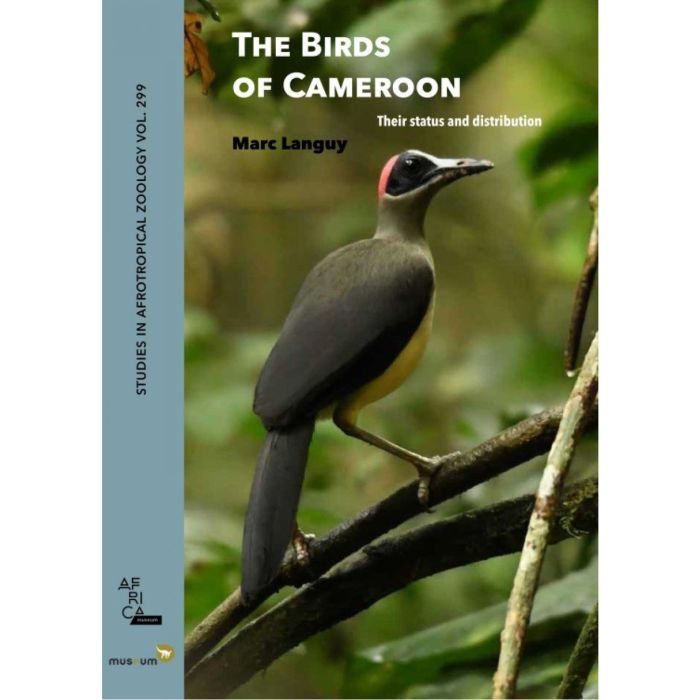My Cart
Your cart is empty
Looks like you haven't made your choice yet.
- Subtotal
The Birds of Cameroon

Their status and distribution
- Africamuseum Tervuren (KMMA)
- Marc Languy
More Information
| Publisher | Africamuseum Tervuren (KMMA) |
|---|---|
| ISBN | 9789492669582 |
| Author(s) | Marc Languy |
| Publication date | September 2019 |
| Dimensions | 240 x 170 mm |
| Illustrations | 500 col. & bw ill. |
| Pages | 568 |
| Language(s) | Eng. ed. |
| extra information | Series "Studies in Afrotropical Zoology", vol. 299 |
Description
Cameroon, thanks to its variety of habitats, is blessed with an impressive biodiversity. Birds are no exception and close to 1,000 species are known to occur in Cameroon. A leading expert in Cameroon ornithology, the author has searched for records from literature and scientific reports published since 1900, and has added thousands of personal observations to build a database of over 67,000 records. For the first time ever, this book gives individual distribution maps for each of the 954 species accepted in the Cameroon list. Accompanying these maps, a short account summarises the status and distribution of each species, providing a wealth of scientific references. This titanic work also provides useful insight on current gaps in knowledge and points to research and surveys that are needed to improve the general and specific knowledge of the fascinating avifauna of Cameroon. The Birds of Cameroon. Their status and distribution is a landmark in Cameroonian ornithology and will find its place in the hands of any naturalist interested in Cameroon.
Additionally, the book offers over 500 stunning pictures of birds, for the pleasure of any nature lover in Cameroon and Africa in general.
Marc Languy completed his Bachelor of Science (Biology) and Master in Population, Environment and Development degrees at the Université catholique de Louvain (Belgium). He then taught Biometrics and Mathematics applied to Biology at the Université de Lyon (France) and his alma mater UCLouvain (Belgium). Languy then moved to Africa where he has been based since 1988, working mostly in Central Africa. He spent 11 years in Cameroon where he led the Cameroon Important Bird Areas Programme for BirdLife International, as well as a major Congo Basin programme for WWF.
À commencer par le trona (1773) et le préhnite (1788), un grand nombre d'espèces minérales ont été décrites à partir de spécimens provenant de localités africaines, dont de fameux sites miniers tels que Tsumeb, en Namibie, et Shinkolobwe, en RD Congo. Cet ouvrage offre une première révision systématique, axée sur l'historique de leur description, des minéraux dont la localité type se situe en Afrique. Il reprend, organisés par pays, tous les minéraux valides, ainsi que les minéraux non valides, les composés non nommés à potentiel d'espèces minérales, et les minéraux dont la localité type n'est pas africaine mais dont l'historique de description comprend une étude de spécimens africains. Trois annexes étendent la révision aux minéraux décrits pour les météorites trouvés en Afrique, à la minéralogie type des territoires insulaires d'États non africains, et aux types de roches définis pour des localités africaines. Partout, le livre vise à attirer l'attention sur la minéralogie type des pays africains en tant qu'aspect spécifique de leur héritage naturel, qui mériterait d'être plus largement connu.
Le Dr Florias Mees est un géologue travaillant au Musée royal de l'Afrique centrale depuis 2007. En sa qualité de chercheur, ses publications portent sur toute une série de sujets, utilisant généralement des caractéristiques minéralogiques comme importante source d'informations ; parallèlement, en tant que conservateur, il est responsable des collections du département de géologie de l'institution. Il a notamment été chargé de la création de la partie minérale de l'exposition permanente actuelle du musée, installée en 2018.
Starting with trona (1773) and prehnite (1788), many minerals have been described as new species for localities in Africa, including some famous mining sites such as Tsumeb in Namibia and Shinkolobwe in the DR Congo. This book offers a first systematic review of minerals with African type localities, focusing on the history of their description. Organized by country, all valid minerals are covered, but also non valid minerals, unnamed compounds with mineral species potential, and minerals with non-African type localities whose description history involves the study of specimens from Africa. Three annexes extend the review to minerals described for meteorites found in Africa, to the type mineralogy of island territories of non-African nations, and to named rock types defined for African localities. Overall, the book aims to draw attention to the type mineralogy of African countries as a specific aspect of their natural heritage, which deserves to be more widely known.
Dr. Florias Mees is a geologist, working at the Royal Museum for Central Africa as researcher and curator since 2007. As a researcher, he has published on a range of subjects, generally using mineralogical characteristics as important source of information. As curator, he is responsible for the collections of the Geology Department. He was in charge of creating the mineral exhibit that is part of the current permanent exposition of the museum, which was installed in 2018.

The Birds of Cameroon
